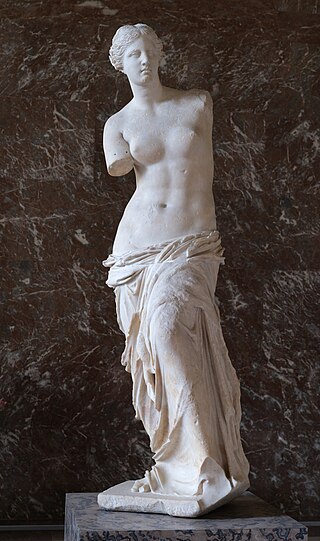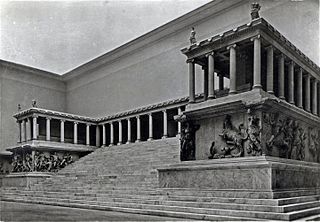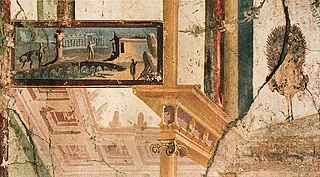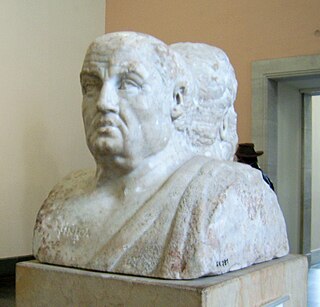
The statuette of Aphrodite known as Aphrodite Heyl in the Antikensammlung Berlin (inventory number 31272) is an especially finely worked terracotta statue from the second century BC.

The statuette of Aphrodite known as Aphrodite Heyl in the Antikensammlung Berlin (inventory number 31272) is an especially finely worked terracotta statue from the second century BC.

This depiction of Aphrodite created from terracotta is particularly sinuous and of outstanding quality. The clothing, made from a thin material, has fallen from her right breast and shows more than it covers. Especially around her abdomen, the material is very tight and allows the contours of her body to be clearly recognised. Since the arms and legs have broken off and do not survive, any attributes which would have helped to identify her are lost and her exact nature cannot be determined for sure. Since the goddess is turning her head away from whatever she held in her hands, it is proposed that there was a further figure, probably a small Eros, to her right. Her raised left leg encourages one to suspect that there was a column base or a larger construction like a pillar here. Her hair is gathered behind her head and is crowned by a tiara.
The front of the 37.6 cm high figure was formed in a mold and then reworked, while the rear received less attention. The folds of skin on the neck were traced with a sharp edge. Her pupils are indicated by slight indentations. On the back at hip height is a large, oval hole which was added to prevent trapped air causing the statue to explode when it was fired in the kiln. It is thought that the statuette was made in Myrina in Asia Minor. This place was famed for its terracotta production, along with Tanagra in Boeotia. Since the two places reached their apogees at different times, this figure is dated to the second century BC. The figure was originally coloured. There are remains of the slipware in the creases of her drapery, blue traces on the diadem and re-red on her coat.
The statue was acquired from the collection of Maximilian von Heyl in 1930 for the Antikensammlung Berlin - from which the figure received the name by which it is now known. Since then she has been shown in the rooms of the permanent exhibition on the Altes Museum.

The Venus de Milo or Aphrodite of Melos is an ancient Greek marble sculpture that was created during the Hellenistic period. Its exact dating is uncertain, but the modern consensus places it in the 2nd century BC, perhaps between 160 and 110 BC. It was rediscovered in 1820 on the island of Milos, Greece, and has been displayed at the Louvre Museum since 1821. Since the statue's discovery, it has become one of the most famous works of ancient Greek sculpture in the world.

Ancient art refers to the many types of art produced by the advanced cultures of ancient societies with different forms of writing, such as those of ancient China, India, Mesopotamia, Persia, Palestine, Egypt, Greece, and Rome. The art of pre-literate societies is normally referred to as prehistoric art and is not covered here. Although some pre-Columbian cultures developed writing during the centuries before the arrival of Europeans, on grounds of dating these are covered at pre-Columbian art and articles such as Maya art, Aztec art, and Olmec art.

Paestum was a major ancient Greek city on the coast of the Tyrrhenian Sea, in Magna Graecia. The ruins of Paestum are famous for their three ancient Greek temples in the Doric order dating from about 550 to 450 BC that are in an excellent state of preservation. The city walls and amphitheatre are largely intact, and the bottom of the walls of many other structures remain, as well as paved roads. The site is open to the public, and there is a modern national museum within it, which also contains the finds from the associated Greek site of Foce del Sele.

The Pergamon Altar was a monumental construction built during the reign of the Ancient Greek King Eumenes II in the first half of the 2nd century BC on one of the terraces of the acropolis of Pergamon in Asia Minor.

The sculpture of ancient Greece is the main surviving type of fine ancient Greek art as, with the exception of painted ancient Greek pottery, almost no ancient Greek painting survives. Modern scholarship identifies three major stages in monumental sculpture in bronze and stone: the Archaic, Classical and Hellenistic. At all periods there were great numbers of Greek terracotta figurines and small sculptures in metal and other materials.

The Berlin Painter is the conventional name given to an Attic Greek vase-painter who is widely regarded as among the most talented vase painters of the early 5th century BC. There are no painter signatures on any of the Berlin Painter's attributed works. From the surviving vases, it is safe to assume that he was a major painter, there are over 400 vases and fragments attributed to him.

The Tanagra figurines are a mold-cast type of Greek terracotta figurines produced from the later fourth century BC, named after the Boeotian town of Tanagra, where many were excavated and which has given its name to the whole class. However, they were produced in many cities. They were coated with a liquid white slip before firing and were sometimes painted afterward in naturalistic tints with watercolors, such as the famous "Dame en Bleu" at the Louvre. They were widely exported around the ancient Greek world. Such figures were made in many other Mediterranean sites, including Alexandria, Tarentum in Magna Graecia, Centuripe in Sicily and Myrina in Mysia.

In the modern study of the culture of ancient Greece and Magna Graecia, a pinax is a votive tablet of painted wood, or terracotta, marble or bronze relief that served as a votive object deposited in a sanctuary or as a memorial affixed within a burial chamber. Such pinakes feature in the classical collections of most comprehensive museums.
The Antikensammlung Berlin is one of the most important collections of classical art in the world, now held in the Altes Museum and Pergamon Museum in Berlin, Germany. It contains thousands of ancient archaeological artefacts from the ancient Greek, Roman, Etruscan and Cypriot civilizations. Its main attraction is the Pergamon Altar and Greek and Roman architectural elements from Priene, Magnesia, Baalbek and Falerii. In addition, the collection includes a large number of ancient sculptures, vases, terracottas, bronzes, sarcophagi, engraved gems and metalwork.

The oinochoe by the Shuvalov Painter in the collection of Antikensammlung Berlin is an erotic depiction from ancient Greek vase painting.

The Berlin Foundry Cup is a red-figure kylix from the early 5th century BC. It is the name vase of the Attic vase painter known conventionally as the Foundry Painter. Its most striking feature is the exterior depiction of activities in an Athenian bronze workshop or foundry. It is an important source on ancient Greek metal-working technology.

The Berlin glass amphora from Olbia is a Hellenistic glass vessel in the shape of an amphora, which is now kept in the Antikensammlung Berlin. Presumably the glass amphora was commissioned by a rich citizen of the city of Olbia, where it was later found, in the second half of the second century. The uniquely shaped vessel was donated to the collection, with some other glass vessels, by Friedrich Ludwig von Gans in 1912 and is now displayed in the Altes Museum with the inventory number 30219, 254. It is, to date, the largest known piece of its kind - and one of the best preserved.

The Double Herm of Socrates and Seneca is an ancient Roman statue from the first half of the third century AD. The herm depicts the Greek philosopher Socrates on one side, and the Roman Stoic Seneca the Younger on the other. It currently belongs to the Antikensammlung Berlin, found in the Altes Museum.

The Fragment from the tomb of Nikarete from the third quarter of the fourth century BC, found near Athens is displayed today in the Antikensammlung of the Altes Museum in Berlin.
The Neck Amphora by Exekias is a neck amphora in the black figure style by the Attic vase painter and potter Exekias. It is found in the possession of the Antikensammlung Berlin under the inventory number F 1720 and is on display in the Altes Museum. It depicts Herakles' battle with the Nemean lion on one side and the sons of Theseus on the other. The amphora could only be restored for the first time almost a hundred and fifty years after its original discovery due to negligence and political difficulties.

The statue of Pericles with the Corinthian Helmet is a lost, life-sized statue of the Athenian statesman and general Pericles. Today, only some of the base survives. Four Roman Imperial-era marble busts modelled after the head of the statue are known.

The Old Drunkard is a female seated statue from the Hellenistic period, which survives in two Roman marble copies. The original was probably also made of marble. This genre sculpture is notable for its stark realism.

The statuette of hoplite found at Dodona is an archaeological find which was purchased in 1880 and is hosted today in Berlin at the Altes Museum
The Athena with cross-strapped aegis is an ancient statue of the Greek goddess Athena, which was made around AD 150 and is now displayed in the Antikensammlung Berlin.

The Berlin Goddess, or Berlin Kore is an Archaic Greek kore made in 570 B.C. discovered in the city of Keratea, which was a part of Attica, Greece. Discovered in 1923 in a complete state, it has since then placed on display at the Antikensammlung Berlin.